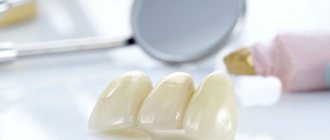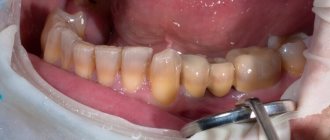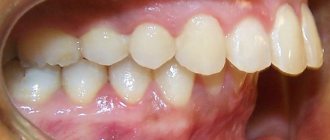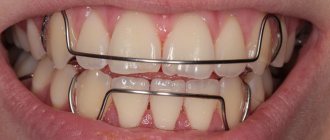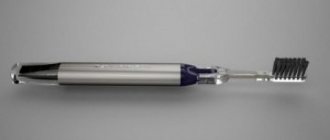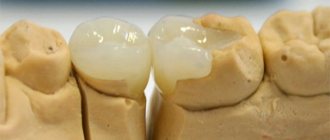Once upon a time, our ancestors made dishes from ceramics, but today they can be used to make the thinnest plates that can turn a smile into a real work of art. We are talking about installing ceramic veneers, with the help of which it is possible to give teeth an ideal shape and aesthetic shade, while preserving their natural transparent structure. Magomed Umatgireevich Dakhkilgov, chief physician of the GERMAN IMPLANTOLOGY CENTER, told us about all the nuances of the unique procedure.
What are porcelain veneers?
A ceramic veneer is a thin plate of high-quality ceramics approximately 0.3 - 0.5 millimeters thick. The microprosthesis is fixed to the external tooth surface using special cement. Veneers correct the color, shape and slight curvature of teeth, trema and diastema, as well as crowding.
Photos before and after installation of ceramic veneers at the Research Center.
Works by Avetisyan R.A., Dakhkilgov M.U., and Karneev A.N.
Preparing for veneering
When the doctor and patient decide to install veneers on the frontal area of one or both jaws, the following must be done:
- Make sure there are no contraindications.
- Undergo an examination of the condition of the teeth (X-ray, orthopantomogram) so that it does not turn out that immediately after installing the veneer the tooth will require treatment, opening the crown part, root resection or other procedures.
- If there is a large amount of hard dental deposits on the teeth, it is necessary to have professional hardware cleaning so that the taking of impressions from the teeth is as accurate as possible.
- The main procedure of the preparatory stage is the preparation of the vestibular surface of the tooth.
It is important to understand that you cannot do without grinding your teeth when installing onlays. With a thickness of 0.5-1.5 mm, veneers installed on unground teeth will make them too large and unsightly. In addition, the removed layer of enamel provides better adhesion to the overlay.
Advantages of ceramic veneers over composite ones
Unlike composite ones, the advantages of ceramic onlays are obvious to any specialist. And here's why: even the most expensive composite is actually plastic; it quickly loses its shine, darkens and delaminates over time. This means that composite veneers are less durable and aesthetically pleasing. Ceramic veneers, on the contrary, cannot be stained, do not change their shape, retain their relief and have the shine of natural teeth. All this makes restorations an excellent tool for creating an ideal smile, without which modern aesthetic dentistry is unthinkable. The only disadvantages of ceramic veneers are the price and complexity of installation, which require the patient to carefully approach the choice of a dental clinic.
Indications for installation of veneers
Dentists recommend installation of veneers for patients who:
- tooth enamel is damaged, dentin is damaged;
- teeth are demineralized;
- the bite is slightly crooked;
- the shade of old fillings or enamel has changed.
The cause of such defects can be injuries, age-related changes in the body, irregular or improper oral care, and genetic characteristics. Dental overlays effectively solve aesthetic problems and make your smile more attractive.
How is a ceramic veneer different from a lumineer?
By and large, Lumineers are the same ceramic veneers, but more matte, less able to convey the transparency and shine of the enamel, which, in my opinion, leads to a less aesthetic result. The statement that there is no need to prepare before placing lumineers on the teeth is also incorrect. Therefore, I personally do not see the point in lumineing, the quality of which does not suit me, and I prefer to work with classic ceramic veneers.
Types of restorations with ceramic veneers
There are two types of porcelain veneers: pressed porcelain and porcelain-fabricated porcelain veneers. Initially, there are no special differences between the two types. The quality of structures is determined by further processing and installation.
Made from pressed ceramic
To create pressed porcelain veneers, wax modeling is first used. A model is created from special wax, according to which a ceramic plate is pressed under high pressure. On the front side of the plate, any anatomical features of the patient’s enamel are recreated. This method is good for accurately conveying the internal surface of the structure adjacent to the tooth.
Manufacturing on a refractor
When making a ceramic veneer using a refractor, special stumps are first created from a refractory mass, and then the ceramic mass is applied to them in layers. The finished structure is subsequently baked in a special oven.
Both types of ceramic veneers are offered. Regardless of the manufacturing method, ceramic onlays are always strictly individualized for the patient and installed at the highest level.
Types of veneers
The main qualities of veneers are always determined by the materials from which they are made. The visual effect of the overlay can last from 5 to 20 years. The strength of the material affects this period. All dentures are fixed with strong glue, which makes it possible to stay on the tooth surface for a long time. All categories of plates are created using a specific technology within 1 to 2 weeks.
Types of veneers:
- Ceramic . These materials include silicon dioxide wafers with a durable porcelain lining.
- Composite materials are used to create another set of veneers .
Ceramic ones better resemble the natural appearance of teeth ; the quality and cost of such plates is the highest. There are many advantages of these pads. They do not darken in any way, are durable, and do not differ in any way from natural teeth. Quality will last approximately 10 years if handled properly.
Composite veneers are budget-friendly and are made from high-quality filling mixtures. They have high strength, but the visual properties are not always pleasing. Such veneers differ significantly from normal teeth in the degree of transparency and shades. Over time, colors may change. The service life under normal use is 5 years.
Contraindications for ceramic veneers
Ceramic veneers can be placed on teeth from the moment when the permanent bite is fully formed, that is, for patients over 18 years of age. However, the decision to undergo veneering should always be balanced and deliberate. The general list of contraindications is as follows:
- Large fillings on front teeth
- Extensive carious lesions
- Gingivitis
- Periodontitis
- Malocclusions
Comparison of E.max and conventional ceramics
To objectively evaluate the quality of E.max models, it is worth comparing them with standard ceramic veneers.
| Characteristic | Conventional ceramic veneers | Veneers E.max |
| Aesthetics | High | Very high – veneers are naturally translucent |
| Strength | Relative | High – ceramics are characterized by increased strength, the risk of veneer chipping is minimized |
| Production: technology | Standard procedure - veneers are created manually | 3D modeling is used for manufacturing, which significantly increases the accuracy of veneer positioning on the tooth. |
| Installation | Mandatory grinding of the enamel layer | Minimal grinding; under favorable conditions, fixation without turning is possible |
| Life time | about 5-7 years | more than 15 years |
| Cost (RUB/piece) | from 15 000 | from 25 000 |
Cost of E.max ceramics
Despite the quality and aesthetic advantages, Emax veneers are insignificantly superior to conventional ceramic analogues in price (if we compare the cost of one tooth, but with multiple restorations the price already differs by 2-3 times). The average cost of E.max veneers in Moscow is from 25 thousand rubles. The price is comparable to modern zirconium dioxide onlays. When planning the cost, it is also worth taking into account the costs of additional procedures - removal of dental plaque, removal of carious formations.
The absence of the need to grind tooth enamel, the highest strength and aesthetics make E.max veneers one of the most effective and safe methods for restoring dental aesthetics. They are perfect for both single treatment and complex problems.
Installation of ceramic veneers
Ceramic veneers are not “seated” onto the tooth using cement, like a filling. Fixing a thin ceramic plate is a complex process. Here it is necessary to follow a clear sequence of actions: first you need to etch the veneer, then wash it with a special solution, then apply a special substance to it, etc. Only by following a clear procedure can you ensure a high-tech installation of a ceramic veneer, in which adhesion between it and the tooth happens at the chemical level. The structure should not just stick to the tooth surface, but practically fuse with it. As for the sequence of actions in a broader sense, it all starts with consultation.
- Consultation
. First of all, it becomes clear what the nature of the problem that a person wants to solve with the help of veneering is. Here, first of all, attention is paid to the bite. If the defect is in the frontal region and is associated with orthodontics, orthodontic treatment with braces or mouthguards to straighten the teeth is first suggested.
- Fitting
. Next, an impression is made, from which diagnostic models are made. Then, using a silicone key (mock-up technology), the desired changes are transferred to the oral cavity. A special composite is inserted into the key and the expected result of future veneering is “squeezed” onto the teeth. Thus, the patient “tryes on” ceramic veneers on his teeth in advance. This model is quite conventional; a real ceramic veneer looks much better, but a person gets a general idea: he sees exactly how the shape of teeth and even their color can be changed.
- Dental treatment.
When the future parameters of the veneers are approved, using special marking burs, the teeth are prepared directly through the composite of the temporary structures. Excessive grinding of natural teeth is avoided; the doctor acts exclusively within the enamel, and in some places even it is not affected.
- Casts
. After preparation, impressions are taken. Temporary structures are then placed on the teeth.
- Creation and installation.
The production of ceramic veneers ranges from a week to three. The finished onlays are tried on and, if the patient has no complaints, they are fixed on the teeth.
Prices for installing veneers
The price of veneers is influenced by the choice of material. Installation of veneers is a complex service, it is performed with local anesthesia and consists of several procedures:
- anesthesia,
- dental treatment,
- taking impressions,
- Dental Smile Design modeling on a computer,
- selection of shade and configuration of dentures by a dental technician,
- microprosthesis molding,
- implantation,
- X-ray.
Initial consultation
- Oral examination
- Making a treatment plan
- Drawing up a treatment estimate
For free
Cost of installing a veneer (1 tooth)
- Anesthesia and pain relief
- Modeling teeth on wax
- X-ray images
- Computer smile modeling
- Tooth treatment
- Taking impressions
- Making a veneer
- Veneer installation
The final cost depends on the material you choose
from RUB 24,500
Before and after installation of 4 veneers on the upper teeth at the Research Center
Make an appointment
right now!
Dakhkilgov Magomed Umatgireevich
Surgeon, Implantologist
Ceramic veneers without turning
Some doctors are disingenuous when they say that the installation of composite veneers, unlike ceramic ones, requires virtually no preparation. In fact, it is impossible to install composite or ceramic veneers without grinding. However, the higher the quality of the specialist’s work, the less impact there is on the teeth. The teeth are processed only with the help of high-quality German burs, precisely centered and having a strictly specified grain size. Moreover, the installation of ceramic veneers is carried out using a high-tech dental microscope. Thus, through the use of modern technologies and materials, we are able to achieve minimal, but very high-quality tooth processing, literally within the enamel. Thanks to this innovative approach, the plate fits perfectly to the prepared surface, which significantly increases the service life of ceramic veneers.
Caring for porcelain veneers
Subject to proper hygiene and periodic dental examinations, veneers can last for more than ten years.
The service life of veneers depends on proper care. Teeth with porcelain veneers should be thoroughly cleaned daily with a toothbrush and floss. Compliance with hygiene rules minimizes the accumulation of plaque and the risk of caries. Veneers, of course, are not subject to caries, but caries can occur in those parts of the tooth that are not covered by the veneer.
Porcelain veneers are designed to improve the appearance of a tooth and cannot withstand significant stress or force. To eliminate excessive force, you need to wean yourself from the habit of biting your nails, opening bottles with your teeth, etc. These forces can cause the veneer to break or become dislodged.
A beautiful white-toothed smile attracts attention and makes a person even more beautiful. Contact a specialist - we will help you!

